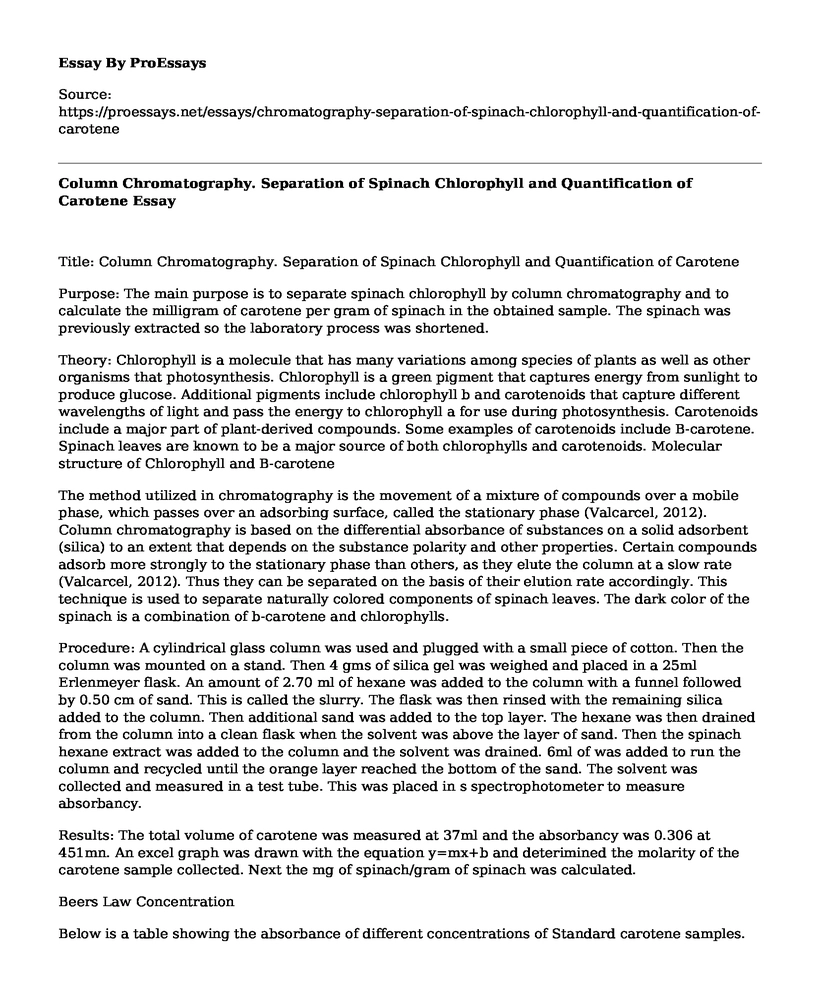Title: Column Chromatography. Separation of Spinach Chlorophyll and Quantification of Carotene
Purpose: The main purpose is to separate spinach chlorophyll by column chromatography and to calculate the milligram of carotene per gram of spinach in the obtained sample. The spinach was previously extracted so the laboratory process was shortened.
Theory: Chlorophyll is a molecule that has many variations among species of plants as well as other organisms that photosynthesis. Chlorophyll is a green pigment that captures energy from sunlight to produce glucose. Additional pigments include chlorophyll b and carotenoids that capture different wavelengths of light and pass the energy to chlorophyll a for use during photosynthesis. Carotenoids include a major part of plant-derived compounds. Some examples of carotenoids include B-carotene. Spinach leaves are known to be a major source of both chlorophylls and carotenoids. Molecular structure of Chlorophyll and B-carotene
The method utilized in chromatography is the movement of a mixture of compounds over a mobile phase, which passes over an adsorbing surface, called the stationary phase (Valcarcel, 2012). Column chromatography is based on the differential absorbance of substances on a solid adsorbent (silica) to an extent that depends on the substance polarity and other properties. Certain compounds adsorb more strongly to the stationary phase than others, as they elute the column at a slow rate (Valcarcel, 2012). Thus they can be separated on the basis of their elution rate accordingly. This technique is used to separate naturally colored components of spinach leaves. The dark color of the spinach is a combination of b-carotene and chlorophylls.
Procedure: A cylindrical glass column was used and plugged with a small piece of cotton. Then the column was mounted on a stand. Then 4 gms of silica gel was weighed and placed in a 25ml Erlenmeyer flask. An amount of 2.70 ml of hexane was added to the column with a funnel followed by 0.50 cm of sand. This is called the slurry. The flask was then rinsed with the remaining silica added to the column. Then additional sand was added to the top layer. The hexane was then drained from the column into a clean flask when the solvent was above the layer of sand. Then the spinach hexane extract was added to the column and the solvent was drained. 6ml of was added to run the column and recycled until the orange layer reached the bottom of the sand. The solvent was collected and measured in a test tube. This was placed in s spectrophotometer to measure absorbancy.
Results: The total volume of carotene was measured at 37ml and the absorbancy was 0.306 at 451mn. An excel graph was drawn with the equation y=mx+b and deterimined the molarity of the carotene sample collected. Next the mg of spinach/gram of spinach was calculated.
Beers Law Concentration
Below is a table showing the absorbance of different concentrations of Standard carotene samples.
[Carotene] (M) Absorbance
4.73 * 10-5 1.388
2.24 * 10-5 0.800
4.73 * 10-5 0.192
4.73 * 10-7 0.070
4.73 * 10-8 0.590
Analysis of Beer Lambert's law graphically
[Carotene]*105 Absorbance
4.73 1.388
2.24 0.8
4.73 0.192
0.0473 0.07
0.00473 0.59
Interpretation
From the above graph the function relating absorbance and concentration is
y = 0.096x + 0.3823. Relating this to the linear equation of y = mx + c. The slope is 0.096 and the y-intercept is 0.3823. The mathematical representation of Beer lamberts law is;
A = epsilon * b * c
= e * b * c
Where:
Epsilon is the wavelength-dependent on molar absorptivity with units of
(M-1Cm-1).A is the measured absorbance
B is the path length and
C is the concentration of the analyteRelating Beers law to the equation of a straight line y= mx +c
0.360 = 0.096x + 0.3823
Thus X which is the concentration at carotene at an absorbance of 0.360
= 0.360 0.3823
0.096
= 0.2323 moles per liter
The volume of the carotene used was 37mls
Therefore;
If 0.2323 moles = 1000mls
? = 35mls
The 36mls of carotene contained 0.00813 moles
The formula of carotene is C60H56
Therefore I mole of Carotene = 776g
0.00813 moles = 6.308g
From the above calculations we can determine the milligrams of carotene in a gram of spinach. Using the correlations below
If 6,308mg of carotene = Xg of Spinach
= 1g of Spinach
Hence; mg of Carotene in I g of Spinach = 6,308/X
Where X is the mass of the spinach in grams
Conclusion
It is thus evident that the application of Beer Lambert's law in spectrometry can be used in column chromatography to determine the concentration of substances such as Carotene in a given sample such as spinach.
References
Valcarcel, M. (2012). Principles of analytical chemistry: a textbook. Springer Science & Business Media.
Cite this page
Column Chromatography. Separation of Spinach Chlorophyll and Quantification of Carotene. (2021, May 17). Retrieved from https://proessays.net/essays/chromatography-separation-of-spinach-chlorophyll-and-quantification-of-carotene
If you are the original author of this essay and no longer wish to have it published on the ProEssays website, please click below to request its removal:
- Compare and Contrast Essay on ALF and PETA
- Organic Food vs. Genetically Modified Food
- Essay Example on Revolutionizing Genome Editing: Introducing Prime Editing Technology
- Animals' Rebellion: The Dream of Old Major - Essay Sample
- Paper Example: Nature vs. Nurture on Child's Development
- Report on Decoding Antibiotic-Free Labels: Standards, Definitions, and Public Health Concerns in Animal Farming
- Paper Example on Hyaline Cartilage







